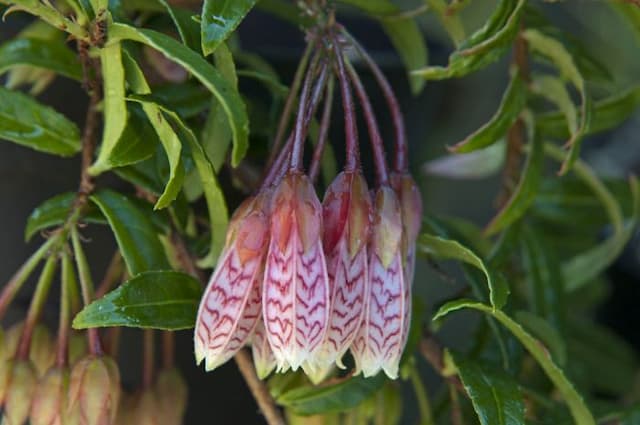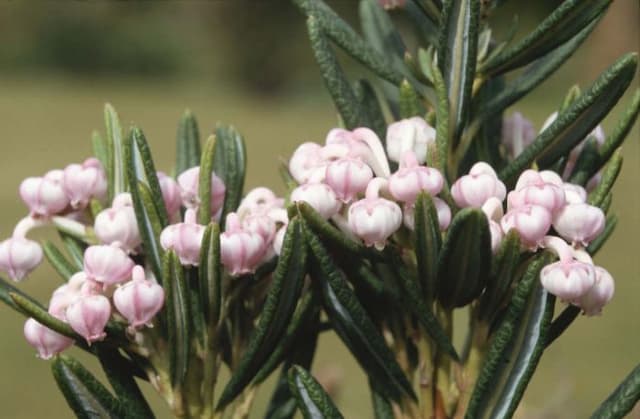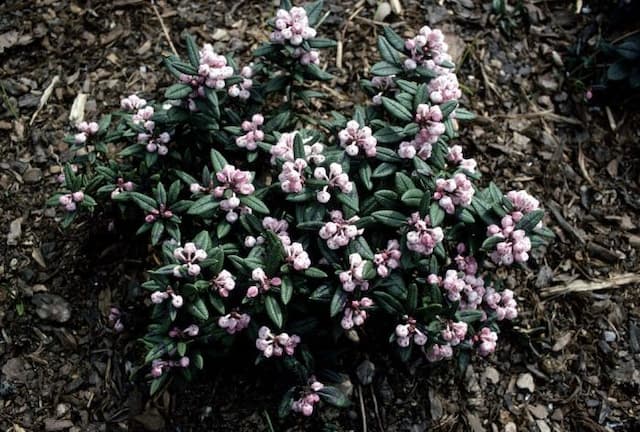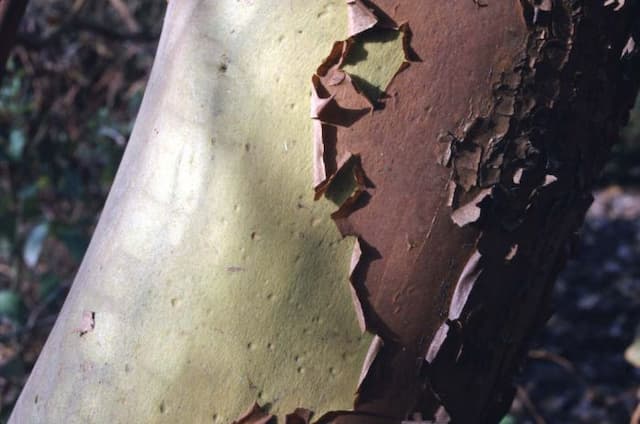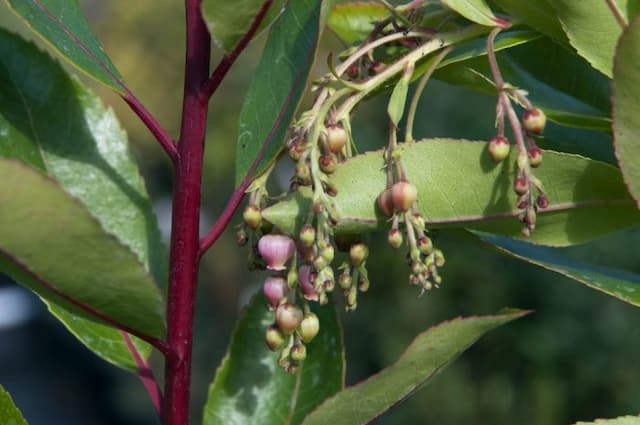Blueberry Flamingo Vaccinium corymbosum Flamingo = 'Hoogi045' (F)
![blueberry [Flamingo]](/_next/image?url=https%3A%2F%2Fplants-admin.emdemapps.com%2Fimages%2Fplants%2F%2Fimages%2F604b650748b18.png&w=3840&q=75)
ABOUT
The plant known as Flamingo Blueberry is distinguishable by its unique appearance, featuring attributes that delight both gardeners and landscaping enthusiasts. The foliage of this blueberry cultivar is striking, emerging in shades of hot pink, much like the flamboyant feathers of its namesake bird. As the leaves mature, they transition through a kaleidoscope of colors, turning from pink to a variegated cream and green pattern, ultimately taking on richer green hues as the growing season progresses. In spring, the Flamingo Blueberry is adorned with small, delicate white flowers that attract pollinators to the garden. These blossoms provide a gentle contrast to the colorful foliage and are a prelude to the fruiting phase of the plant. As the season advances, the flowers give way to the blueberries, known for their delectable sweet taste. The fruit is small, round, and bears the typical blue-purple tone commonly associated with blueberries. The overall form of the Flamingo Blueberry plant is rounded and shrub-like, with a branching habit that supports both its ornamental leaves and fruitful bounty. The branches themselves are sturdy and contribute to the plant's lush, full appearance. Seasonal changes continue to grace the plant with color transformations, as the leaves may take on reddish or purple hues with the approach of cooler weather, providing a final splash of color before the resting period of winter.
About this plant
 Names
NamesFamily
Ericaceae
Synonyms
Highbush Blueberry, Flamingo Blueberry
Common names
Vaccinium corymbosum Flamingo = 'Hoogi045' (F).
 Toxicity
ToxicityTo humans
The plant commonly known as Blueberry 'Flamingo' is not known to be toxic to humans. In fact, blueberries are widely consumed and are known for their nutritional benefits. However, like any plant, individual allergic reactions are possible. If a person is known to have specific fruit allergies, they should proceed with caution and consult with a healthcare provider. There are no general symptoms of poisoning associated with the ingestion of blueberries by humans, as this plant is typically considered safe for human consumption.
To pets
Blueberry 'Flamingo' is considered non-toxic to pets, including dogs and cats. Blueberries are often recommended as a healthy treat for pets. However, it's important for pet owners to introduce any new food in moderation to avoid potential digestive upset. There are no known toxic effects or specific symptoms of poisoning in pets from ingesting blueberries. However, as with any food item not typical to a pet's regular diet, overconsumption can lead to gastrointestinal discomfort or more severe issues if the plant parts cause an obstruction.
 Characteristics
CharacteristicsLife cycle
Perennials
Foliage type
Deciduous
Color of leaves
Mixed
Flower color
White
Height
4-6 feet (1.2-1.8 meters)
Spread
4-6 feet (1.2-1.8 meters)
Plant type
Shrub
Hardiness zones
5
Native area
North America
Benefits
 General Benefits
General Benefits- Enhances Landscape Aesthetics: The Flamingo Blueberry adds a unique visual appeal to gardens with its attractive pink and white variegated leaves and pink or white flowers.
- Edible Fruit Production: It produces edible blueberries that can be consumed fresh, baked into desserts, or preserved for later use.
- Wildlife Attraction: The blueberry bushes attract birds and beneficial insects to the garden, promoting biodiversity.
- Seasonal Interest: This plant offers year-round interest with foliage that changes color through the seasons and springtime blooms.
- Cold Hardy: As a hardy plant, it can survive in colder climates, making it suitable for a range of gardens.
- Low Maintenance: Once established, the Flamingo Blueberry requires minimal care, making it an excellent choice for both novice and experienced gardeners.
 Medical Properties
Medical Properties- Antioxidant Properties: Blueberry (Vaccinium corymbosum) extracts are known for their high levels of antioxidants which can help in neutralizing free radicals in the body.
- Anti-diabetic Effects: Some studies suggest that blueberries may improve insulin sensitivity and glucose metabolism, potentially aiding in diabetes management.
- Cardiovascular Health: Compounds in blueberries, such as flavonoids, have been linked to reducing blood pressure and other risk factors for heart diseases.
- Neuroprotective Effects: Blueberries may have beneficial effects on the brain, potentially improving cognitive functions and offering protection against neurodegenerative diseases.
- Anti-inflammatory: The plant contains substances that may have anti-inflammatory properties, which could potentially help in reducing inflammation related conditions.
- Urinary Tract Health: Blueberries are related to cranberries and can potentially help prevent urinary tract infections due to similar substances that inhibit bacteria from adhering to the bladder walls.
 Air-purifying Qualities
Air-purifying QualitiesThis plant is not specifically known for air purifying qualities.
 Other Uses
Other Uses- The blueberry 'Flamingo' can be used as a natural dye for fabrics and crafts, imparting a subtle bluish or purplish hue.
- In culinary arts, the blueberry 'Flamingo' can be infused in syrups or vinegars for an added flavor and color twist in gourmet dishes.
- Landscape designers often utilize the blueberry 'Flamingo' for its unique foliage and striking flowers to create visually appealing garden compositions.
- The plant can be used in educational settings, such as schools or nature centers, to teach about plant biology and the growth cycle of fruit-bearing shrubs.
- Blueberry 'Flamingo' can be incorporated into wildlife gardens to attract and provide sustenance for bees, butterflies, and birds.
- Photographers and artists may use the plant as a subject or inspiration for their work because of its attractive blossoms and fruit.
- Fall foliage of the blueberry 'Flamingo' can be used in autumnal decorations, such as wreaths or centerpieces, because of its vibrant color change.
- Horticultural therapy programs can include tending to blueberry 'Flamingo' as an activity to help improve mental health and well-being.
- The aromatic qualities of blueberry 'Flamingo' blossoms can be utilized in the creation of natural perfumes or potpourris.
- During winter, the dormant branches of the blueberry 'Flamingo' can be pruned and used for rustic crafts or as support stakes for other plants in the garden.
Interesting Facts
 Feng Shui
Feng ShuiThe Blueberry 'Flamingo' is not used in Feng Shui practice.
 Zodiac Sign Compitability
Zodiac Sign CompitabilityThe Blueberry 'Flamingo' is not used in astrology practice.
 Plant Symbolism
Plant Symbolism- Perseverance: Vaccinium corymbosum, also known as blueberry, often symbolizes perseverance as the plant can survive harsh conditions and still produce fruit.
- Longevity: The blueberry plant, with its ability to live and produce for many years, represents longevity and the passage of time.
- Protection: Blueberries have been thought to offer protection against negative influences, possibly due to their rich antioxidant properties.
- Abundance: A healthy blueberry bush produces an abundant crop, symbolizing prosperity and generosity in providing for others.
- Good Health: Associated with well-being and vitality thanks to the nutritious value of its fruit, blueberries symbolize good health and dietary wellness.
- Wisdom: In some native cultures, blueberries are associated with wisdom, due to their deep blue color, which is often connected with intelligence and thoughtfulness.
 Water
WaterThe Blueberry 'Flamingo' prefers consistently moist soil, so regular watering is essential. During the growing season, water the plant about 1 to 2 inches per week, ensuring the soil stays evenly damp but not waterlogged. In hot, dry periods, increase the frequency to maintain moisture levels but be careful not to overwater. Established plants may require less frequent watering, depending on rainfall and soil conditions. Use a soaker hose or drip irrigation to apply water directly to the base of the plant, which helps to minimize water on the foliage and prevents disease.
 Light
LightBlueberry 'Flamingo' thrives best in full sun, meaning at least 6 to 8 hours of direct sunlight per day. Even though the plant can tolerate partial shade, it will produce the best fruit yield and strongest growth in full sun. Choose a spot with well-drained soil and ample sunlight to ensure your blueberry bush remains healthy and productive.
 Temperature
TemperatureBlueberry 'Flamingo' is tolerant of a wide range of temperatures but grows best within a range of 45°F to 85°F. It can survive minimum winter temperatures down to about -10°F once established. During the growing season, a temperature range of 60°F to 75°F is considered ideal for this blueberry bush to thrive.
 Pruning
PruningPruning Blueberry 'Flamingo' helps to maintain the plant's shape, improve air circulation, and encourage healthy fruit production. Prune in late winter to early spring before new growth starts, removing dead or damaged branches and any that are crossing or crowded. Thin out older stems to promote vigorous new growth. Pruning should be done annually to keep the bush productive and manageable.
 Cleaning
CleaningAs needed
 Soil
SoilThe best soil mix for the Blueberry 'Flamingo' should be well-draining and rich in organic matter, with a soil pH between 4.5 and 5.5. A mix of peat moss, pine bark, and perlite or sand makes a good substrate, ensuring acidity and proper drainage.
 Repotting
RepottingThe Blueberry 'Flamingo' should be repotted every 2 to 3 years to replenish its soil and accommodate root growth. Young plants may need repotting more frequently, while mature plants can be refreshed with new topsoil.
 Humidity & Misting
Humidity & MistingBlueberry 'Flamingo' prefers moderate humidity levels around 50-60%. It's not particularly demanding regarding humidity but should not be placed in overly dry environments.
 Suitable locations
Suitable locationsIndoor
Provide acidic soil, bright light, and cool temps.
Outdoor
Plant in acidic soil, full sun to part shade.
Hardiness zone
5-8 USDA
 Life cycle
Life cycleBlueberry 'Flamingo' begins its life cycle as a dormant seed, typically requiring stratification—a period of cold exposure—to germinate. Upon germination in spring, it develops into a seedling and forms a root system and foliage. As the plant matures, it enters a vegetative stage, characterized by the growth of stems, leaves, and followed by the development of pinkish-white flowers. Successful pollination of the flowers, often aided by bees, leads to the formation of green berries, which gradually ripen to a deep blue color. The plant reaches full fruit production after a few years, and this stage can last many years with proper care. As a perennial, the blueberry 'Flamingo' will go through annual cycles of foliage growth, flowering, fruiting, and dormancy, typically with a decrease in vigor and productivity as the plant ages.
 Propogation
PropogationPropogation time
Spring-Early Summer
Vaccinium corymbosum Flamingo, commonly known as the Flamingo Blueberry, is typically propagated through softwood cuttings. This method is favored for its effectiveness in producing true-to-type clones of the mother plant. The best time to take softwood cuttings is in late spring to early summer, when new growth is mature enough to handle cutting but still in its tender stage. A cutting of about 4 to 6 inches (approximately 10 to 15 centimeters) is snipped from a healthy shoot, with the lower leaves removed. Dipping the cut end into a rooting hormone can enhance root development. The cutting is then planted in a well-draining soil mix and kept under high humidity with consistent moisture until roots are established, which typically takes several weeks.
